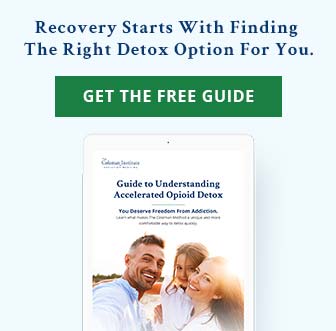
Chronic Pain FAQs
- How does pain affect my body?
- Is it possible to develop an addiction to painkillers when taken as prescribed by a doctor?
- Why do opiates (narcotics) make Chronic Pain worse?
- How will stopping opiate use improve my chronic pain?
- How can chronic pain patients manage pain without relying on opiates?
- What is the best way to detox from opiates?
- Why use Naltrexone therapy?
- What should I do if my chronic pain worsens?
- What happens if I must take opiate painkillers during Naltrexone therapy?
- Will I experience any risks or side effects?
1. How does pain affect my body?
There are two very different types of pain: acute and chronic.
Acute Pain: Acute pain is the body’s way of responding to a wide range of physical dangers. For example, say you touch a hot stove. When you do this, your pain receptors (nociceptors) will detect a dangerous situation and relay that information to your brain — which then makes you act appropriately. So, you remove your hand before it badly burns. While the pain may hurt, your reaction is an important protective device.
Chronic Pain: Chronic pain does not function in the same way as acute pain. When you experience pain for an extended period of time, your nociceptors overload and are more sensitive to pain signals. They fire off at lower levels, making you feel more pain than what actually exists. So, while your body may not be in danger, your pain receptors continue overreacting, resulting in the potential need for prolonged medication use or other pain management strategies.
2. Is it possible to develop a dependence or addiction to pain medication when taken as prescribed by a doctor?
The risk of developing a dependence or addiction to pain medication exists even when they are taken strictly as prescribed by a physician. The addictive properties of opioids can lead to a compulsion to continue using the drug, surpassing the recommended dosage. Transparent and ongoing communication between patients and healthcare providers is crucial. Open dialogues about the risks involved, the progression of treatment, any experiences of side effects, and the exploration of alternative pain management strategies are essential components in preventing dependency and addressing any emerging issues promptly.
3. Why do opiates (narcotics) make Chronic Pain worse?
When you first begin taking opiates to treat chronic pain, they provide relief, energy, a sense of well-being, and even euphoria. They achieve these results by attaching to your brain’s endorphin receptors. Unfortunately, after you take narcotics for an extended time, your brain reduces the amount of endorphins it produces, thus decreasing your body’s natural painkillers. Without natural endorphins, you have to take opiate painkillers just to avoid withdrawal and feel normal.
To make matters worse, the opiates confuse your brain’s pathways. So, you have a reduced ability to decipher which pain needs attention to protect you and which you can ignore. Ultimately, the same medicine you take to avoid withdrawal symptoms and provide pain relief steadily makes your chronic pain worse — creating a cyclical relationship.
4. How will stopping opiate use improve my chronic pain?
When you stop taking opiates through rapid detox or other treatment programs, your brain and body can return to a normal state. Your body will begin producing its own endorphins again, and you can expect:
- Less intense pain
- Less frequent pain
- No more opiate side effects
- No more withdrawal symptoms
This process can take months to complete, but our patients almost always report that they have less pain within a few weeks of completing their detox.
5. How can chronic pain patients manage pain without relying on opiates?
Chronic pain sufferers can try to avoid reliance on opiates with multifaceted approaches that can combine non-opiate medications, lifestyle modifications, physical therapy, and psychological support. Engaging in regular, moderate exercise and implementing stress-reduction techniques, such as mindfulness and meditation, can also help to improve pain management. Psychological support and counseling can aid in addressing the mental and emotional aspects of chronic pain, providing coping strategies, and enhancing resilience.
6. What is the best way to detox from opiates?
We believe an outpatient Accelerated Opiate Detoxification (AOD) method is the safest, most convenient way to detox from opiates. Rather than spending several months tapering your dosages — and experiencing uncomfortable opioid withdrawal symptoms the whole time — AOD helps you comfortably detox in as little as three days. With this approach, we have a 98% detox completion rate.
7. Why use Naltrexone therapy?
Naltrexone is a non-addictive medication that binds to your brain’s opiate receptors, reducing any cravings you may experience after detox. From our experience, patients who use Naltrexone therapy for at least six months after detoxing recover more easily and permanently from their opiate dependency and chronic pain. At many locations, we use specially formulated Naltrexone injections that last for weeks, so you don’t have to worry about remembering to take a pill each day.
8. What should I do if my chronic pain worsens?
After dealing with chronic pain, worrying about your pain returning if you don’t take opiates is completely understandable. Thankfully, many effective non-narcotic medicines exist for pain. In addition, other treatments can dramatically reduce your chronic pain without medication, such as massage therapy, physical therapy and spinal cord stimulators. In our experience, many of these options prove very helpful to patients once they detox completely and their body no longer craves narcotics.
9. What happens if I must take opiate painkillers during Naltrexone therapy?
If a patient experiences a painful, life-threatening, or other traumatic event or emergency, such as a car accident or escalating pain, and needs opiate painkillers while taking Naltrexone. They would be able to take an opiate painkiller within 6 to 12 hours.
10. Will I experience any risks or side effects?
Our outpatient Accelerated Opiate Detox is very safe, but as with any medical procedure, some side effects, risks and potential complications exist. These include:
- Discomfort: While our rapid outpatient opiate detox program can reduce the severity of many withdrawal symptoms, some patients experience minor discomfort during the detox. If this occurs, we provide additional medication for comfort.
- Overdose Risk: The risk of overdose is high if patients abuse opiates after an extended period of abstinence.
Let’s Take the Next Step Together.
Have questions or want to learn more? Contact us today at 804-294-2212.


